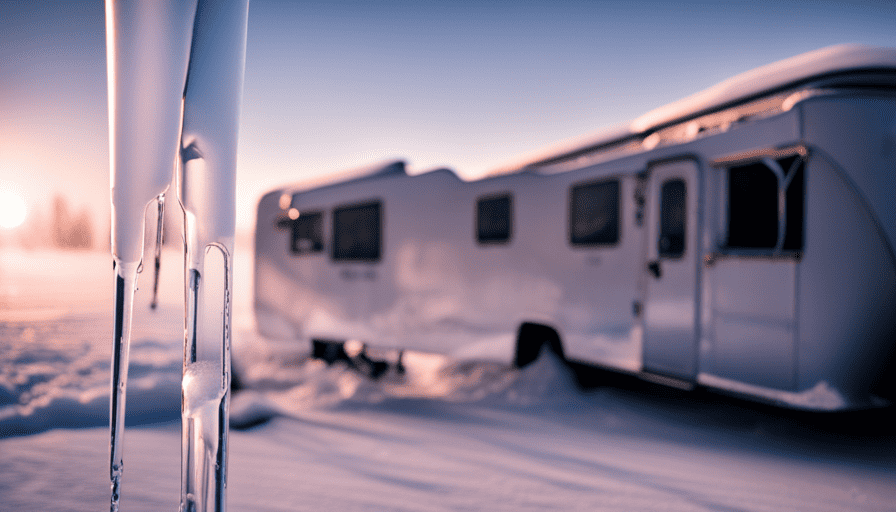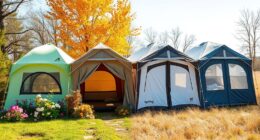Winter camping provides a rejuvenating adventure, but it is essential to stay warm and comfortable inside your camper. When the chilly wind howls outside, staying cozy and warm indoors, protected from the elements, is vital. This is where the significance of proper insulation comes into play.
In this article, I will guide you through the steps to effectively insulate your camper for winter, ensuring that you stay warm and toasty no matter how low the temperatures drop. By assessing your camper’s current insulation, sealing any drafts or leaks, and insulating windows and doors, you can significantly improve its ability to retain heat. Additionally, using insulating curtains or blinds, installing foam or reflective insulation panels, and adding weatherstripping to exterior openings will further enhance insulation. To combat the chilly floors, insulated skirting around the base of the camper is a great option. And don’t forget about staying warm during the night – portable heaters or electric blankets can make all the difference.
Throughout this article, I will provide you with thorough and detailed instructions, ensuring that you have all the knowledge you need to insulate your camper properly for winter camping. So let’s dive in and get started on creating a cozy winter haven inside your camper.
Key Takeaways
- Assess current insulation and seal drafts and leaks to improve energy efficiency and prevent heat loss.
- Use a combination of weatherstripping, caulk, window insulation film, draft stoppers, and window insulation kits to insulate windows and doors.
- Use insulated curtains or blinds made from thick, heavy fabrics with thermal backing to block drafts and trap heat inside the camper.
- Consider using foam or reflective insulation panels to provide an additional layer of insulation and reduce heat loss.
Assess Your Camper’s Current Insulation
Before you begin insulating your camper for winter, it’s important to assess its current level of insulation. Assessing the insulation effectiveness of your camper will help you identify any weak points that need to be addressed.
Start by checking the walls, ceiling, and floor for any signs of poor insulation, such as drafts or cold spots. Pay close attention to areas where there may be gaps or cracks, such as around windows, doors, and vents.
To assess the insulation effectiveness, you can use a thermal imaging camera or a simple touch test. Run your hand along the walls and feel for any cold spots or temperature differences. If you notice a significant difference in temperature, it’s a sign that the insulation may be lacking in those areas.
Next, inspect the seals around windows and doors. Look for any gaps or cracks that could be letting cold air in. Check the weatherstripping and caulking, and replace any damaged or worn-out seals.
Identifying weak points in your camper’s insulation is crucial for ensuring a warm and comfortable winter camping experience. Once you have assessed the current insulation, you can move on to the next step of sealing any drafts or leaks, which will further improve the insulation effectiveness of your camper.
Seal Any Drafts or Leaks
After making sure that all the sneaky little cracks and crevices have been sealed up tight, your cozy little home on wheels will be as snug as a bug in a rug. Sealing any drafts or leaks in your camper is crucial for preventing heat loss and maintaining a comfortable temperature during winter camping. There are various sealing techniques you can utilize to achieve this goal.
First, inspect all the windows, doors, vents, and any other openings in your camper. Look for any gaps, cracks, or areas where cold air could enter or warm air could escape. Use weatherstripping or caulk to seal these areas effectively. Weatherstripping can be applied around windows and doors, creating a tight seal when closed.
Another technique is using foam insulation. This can be applied to larger gaps or holes where air might be leaking. Spray foam insulation expands to fill the space, creating a barrier against drafts. Pay attention to areas around pipes, electrical outlets, and any other openings in the walls or floor.
By properly sealing any drafts or leaks in your camper, you can greatly reduce heat loss and create a more energy-efficient living space.
Now, let’s move on to the next section and learn how to insulate windows and doors without compromising visibility or accessibility.
Insulate Windows and Doors
Enhancing the coziness of your mobile home, insulating windows and doors ensures maximum comfort and energy efficiency. When it comes to keeping the cold air out and the warm air in, properly insulating these areas is essential. By doing so, you can prevent drafts, reduce heat loss, and ultimately create a more comfortable living space.
Insulating windows and doors can be achieved through various methods. One effective way is by using weatherstripping. This flexible material can be applied around the edges of windows and doors to seal any gaps and prevent air leakage. Additionally, applying caulk or sealant to any cracks or openings can further enhance insulation.
To provide a visual representation, I have created a table below showcasing some common materials and techniques used to insulate windows and doors:
| Material/Technique | Description |
|---|---|
| Weatherstripping | Adhesive strip that seals gaps around windows and doors |
| Caulk/Sealant | Fills cracks and gaps to prevent air leakage |
| Window Insulation Film | Transparent plastic film applied to windows to create a barrier |
| Draft Stoppers | Placed at the bottom of doors to block drafts |
| Window Insulation Kits | Includes shrink film, double-sided tape, and a hairdryer for installation |
By insulating windows and doors, you can significantly improve the energy efficiency of your camper. This will not only keep you warm during winter but also save on heating costs. In the next section, we will explore the use of insulating curtains or blinds as another effective method to insulate your camper for winter.
Use Insulating Curtains or Blinds
To create a cozy and energy-efficient living space, consider using insulating curtains or blinds in your mobile home. Insulating curtains are designed to block out drafts and keep the heat in during the winter months. These curtains are made from thick, heavy fabrics that have a high insulation value. They’re usually lined with a thermal backing that helps trap heat inside the camper.
Additionally, insulating curtains can also help reduce outside noise and provide privacy.
Thermal blinds are another option for insulating your camper. These blinds have a special coating that helps reflect heat back into the room, keeping it warm and cozy. They’re typically made from materials like PVC or aluminum, which are known for their insulating properties. Thermal blinds can be adjusted to let in natural light during the day and closed at night to retain heat.
When choosing insulating curtains or blinds, it’s important to measure your windows accurately to ensure a proper fit. You may also want to consider using a combination of both curtains and blinds for maximum insulation. By using insulating curtains or blinds, you can create a barrier against the cold and reduce heat loss in your mobile home.
To further enhance the insulation of your camper, the next step is to install foam or reflective insulation panels. These panels can provide an additional layer of insulation and help keep the cold air out and the warm air in.
Install Foam or Reflective Insulation Panels
Installing foam or reflective insulation panels in your mobile home is like wrapping it in a cozy blanket, keeping the warmth inside and the cold air out. Not only does this method provide excellent insulation, but it also offers cost-effective alternatives compared to other insulation options.
Foam or reflective insulation panels are affordable and readily available, making them a popular choice for insulating campers during the winter months. One of the major benefits of using foam or reflective insulation panels is their energy efficiency. These panels effectively trap heat inside the camper, reducing the need for constant heating and lowering energy consumption.
By minimizing heat loss through the walls, these insulation panels help to maintain a comfortable temperature inside the camper even in freezing weather conditions. This not only keeps you warm and cozy but also saves you money on heating costs. When installing foam or reflective insulation panels, it is important to ensure a thorough and proper installation. Pay attention to any gaps or seams that may allow air to leak through.
By sealing these gaps and properly insulating the walls, you can maximize the energy efficiency benefits of these panels. Next, let’s discuss how to insulate the floor and ceiling of your camper to further enhance its winter insulation capabilities.
Insulate the Floor and Ceiling
Transform your mobile home into a cozy retreat by properly insulating the floor and ceiling, ensuring warmth and comfort all winter long. When it comes to insulating your camper for winter, it’s crucial to pay attention to the floor and ceiling. Good insulation in these areas will help maintain a consistent temperature inside the camper and prevent cold drafts from seeping in.
Start by insulating the floor. One effective method is to install foam insulation panels underneath the flooring. These panels provide a barrier against the cold ground and help retain heat inside the camper. You can also use reflective insulation panels, which have a reflective surface that helps reflect heat back into the camper. This dual-layered approach provides better insulation and improves energy efficiency.
Moving on to the ceiling, proper insulation is equally important. Use insulation batts or rolls to cover the entire ceiling area. These insulation materials are easy to handle and install. They trap heat inside and prevent cold air from seeping in through the roof. By insulating the ceiling, you create a thermal barrier that keeps your camper warm and cozy during the winter months.
To further enhance the insulation, consider adding weatherstripping to exterior openings. This will help seal any gaps or cracks around doors, windows, and vents, preventing cold air from infiltrating the camper. With a well-insulated floor and ceiling, combined with proper weatherstripping, your camper will be ready to brave the winter chill.
Add Weatherstripping to Exterior Openings
Make your mobile home even cozier by sealing up any gaps or cracks around your doors, windows, and vents with weatherstripping, keeping the cold air outside where it belongs. Weatherstripping is a great way to improve energy efficiency and make your camper more comfortable during the winter months. Here are three reasons why weatherstripping is beneficial:
-
Energy Efficiency: By sealing gaps and cracks, weatherstripping prevents cold air from entering and warm air from escaping. This reduces the amount of energy needed to heat your camper, resulting in lower heating bills.
-
Improved Comfort: Weatherstripping helps to maintain a consistent temperature inside your camper by blocking drafts. This creates a more comfortable living environment and reduces the need for additional heating sources.
-
Noise Reduction: In addition to keeping out cold air, weatherstripping also helps to minimize outside noise. This can make your camper a quieter and more peaceful space, allowing you to enjoy a good night’s sleep or relax during the day.
There are various types of weatherstripping materials available, including adhesive-backed foam tape, V-strip, door sweeps, and silicone caulk. Each material has its own effectiveness and suitability for different areas of your camper. Consider the specific needs of your camper and choose the appropriate weatherstripping material accordingly.
To further enhance insulation, the next step is to use insulated skirting around the base of the camper. This will provide an additional barrier against cold air and help to maintain a warm interior temperature.
Use Insulated Skirting Around the Base of the Camper
To increase the warmth and energy efficiency of your mobile home, try using insulated skirting around the base, which can reduce heat loss by up to 25%. Insulated skirting is a great addition to your camper during the winter months, as it provides a barrier between the cold ground and your living space. This helps to prevent drafts and keep the interior temperature more stable.
One of the main benefits of insulated skirting is its ability to reduce heat loss. By creating a sealed barrier around the base of the camper, it prevents cold air from entering and warm air from escaping. This can significantly improve the overall energy efficiency of your camper, reducing the need for excessive heating and lowering utility costs.
Insulated skirting also offers protection against moisture and pests. It helps to keep the underside of your camper dry by preventing moisture from seeping through the ground. This can help to prevent issues such as mold and rot. Additionally, the skirting acts as a deterrent to pests, preventing them from entering and potentially causing damage to your camper.
While insulated skirting is an effective method of winterizing your camper, there are alternative methods you can consider. In the next section, we’ll explore the option of using portable heaters or electric blankets to further increase the warmth and comfort of your camper during the winter months.
Consider Using Portable Heaters or Electric Blankets
Consider using portable heaters or electric blankets to cozy up your mobile home during cold weather. Here are three reasons why these options can be a great addition to your winter camping gear:
-
Portable Heater Safety: When choosing a portable heater, prioritize safety features such as automatic shut-off and tip-over protection. Look for heaters that are specifically designed for indoor use and have been tested for safety. It’s also important to keep flammable materials away from the heater and never leave it unattended.
-
Energy Efficient Electric Blankets: Electric blankets are a fantastic way to stay warm and save energy. Look for blankets with adjustable temperature settings and timers, so you can customize your comfort level and avoid overheating. Opt for blankets with low voltage technology, as they consume less energy and are safer to use.
-
Cost-effective Solution: Both portable heaters and electric blankets are cost-effective options for heating your camper during winter. They consume less energy compared to traditional heating methods, and you can easily control the temperature to avoid wasting energy.
By considering these options, you can ensure a warm and cozy living space in your camper during the winter months. However, it’s important to remember that proper ventilation is crucial to prevent condensation and maintain air quality.
Monitor and Maintain Proper Ventilation
Ensuring fresh air circulates throughout your cozy mobile home is as vital as a breath of crisp winter air. Proper ventilation benefits both your health and the condition of your camper during the colder months. It helps remove excess moisture, prevents condensation buildup, and eliminates stale odors. However, it’s important to be aware of potential ventilation issues that can arise in winter.
One common issue is the temptation to seal off all windows and vents to keep the cold air out. While it may seem like a good idea, it can lead to a buildup of moisture and mold growth. To maintain proper ventilation, it’s recommended to open windows for a short period each day, even if it’s just for a few minutes. This allows fresh air to circulate and stale air to escape.
Another potential issue is the risk of drafts when opening windows. To mitigate this, you can use draft stoppers or weatherstripping to seal any gaps. Additionally, using window coverings such as thermal curtains can help insulate and reduce heat loss while still allowing for proper ventilation.
Incorporating a 3 column and 3 row table can further enhance your understanding of proper ventilation in a camper during winter:
| Ventilation Issue | Potential Consequences | Solutions |
|---|---|---|
| Sealed Windows | Excess moisture, mold growth | Open windows for short periods daily |
| Drafts | Heat loss, discomfort | Use draft stoppers, weatherstripping, and thermal curtains |
| Stale Air | Odors, poor air quality | Use air purifiers, open windows for fresh air circulation |
By being mindful of proper ventilation and addressing potential issues, you can create a cozy and healthy living environment in your camper throughout the winter season.
Frequently Asked Questions
Can I use regular curtains or blinds instead of insulating curtains or blinds?
Yes, regular curtains or blinds can provide some insulation for your camper during winter. However, if you want to maximize the insulation, it’s recommended to use thermal blankets or bubble wrap. Thermal blankets are designed specifically to trap heat and keep cold air out, providing better insulation than regular curtains. Bubble wrap can also be used as a temporary solution by placing it over windows to create an additional layer of insulation.
How can I insulate the windows and doors without blocking natural light?
To insulate camper windows while maximizing natural light, I recommend using thermal window film. This innovative solution allows sunlight to pass through while reducing heat loss. Simply apply the film to the inside of the windows and use a hairdryer to smooth out any wrinkles.
Another option is to use insulating window inserts made of clear acrylic or polycarbonate. These inserts create an additional barrier against cold air without blocking your view or natural light.
What is the difference between foam insulation panels and reflective insulation panels?
When comparing foam insulation panels and reflective insulation panels, there are several key differences to consider.
Foam insulation panels are typically made from materials like polyurethane and provide excellent thermal insulation. They’re easy to install and have a high R-value, which measures their resistance to heat flow.
On the other hand, reflective insulation panels are made with a layer of aluminum foil and are designed to reflect radiant heat. They’re lightweight, easy to handle, and can be effective in reducing heat transfer. However, they may not provide as much insulation as foam panels.
Ultimately, the choice between foam insulation panels and reflective insulation panels will depend on your specific needs and budget.
Can I use regular weatherstripping instead of adding weatherstripping to exterior openings?
Regular weatherstripping may not be the most effective solution for insulating camper windows. Instead, it’s recommended to use insulation tape specifically designed for exterior openings. This tape is designed to provide a tight seal and prevent drafts.
Additionally, there are alternative methods for insulating camper windows, such as using thermal curtains or window insulation film. These options can help improve insulation and retain heat inside the camper during the winter months.
How do I properly maintain the ventilation in my camper during winter?
Maintaining proper ventilation in my camper during winter is crucial to prevent condensation buildup and maintain proper moisture levels. It’s a delicate balance, as I don’t want to let in too much cold air but also need to avoid excess moisture.
To achieve this, I ensure that my camper has adequate ventilation through vents and windows, while also using a dehumidifier or moisture-absorbing products. Regularly monitoring and adjusting the ventilation keeps my camper comfortable and condensation-free.
What Are the Best Methods to Insulate a Camper for Winter Use?
When winter sets in, insulating a camper for winter becomes crucial to maintain a comfortable temperature. Optimal methods include using insulation boards or foam panels for the walls, floor, and ceiling. Weatherstripping windows and doors, as well as applying thermal curtains, can prevent drafts. Sealing any gaps and using insulation tape on exposed pipes aids in warmth retention. Additionally, investing in a portable heater or electric blankets can provide extra warmth during colder nights.
Is the Process of Insulating a Camper for Winter Different from Regular Insulation?
Yes, the process of insulating a camper for winter is different from regular insulation. To insulate camper effectively for winter, special attention needs to be given to preventing heat loss, controlling moisture, and ensuring proper ventilation. It requires specific materials and techniques to withstand colder temperatures and harsh weather conditions.
Conclusion
As I wrap up this guide on how to insulate a camper for winter, I can’t help but feel a sense of excitement and anticipation. With each step, I’ve shared valuable tips and techniques to ensure your camper stays warm and cozy during the cold months. Now that you’ve mastered the basics of camper insulation, it’s time to dive into some additional tips for camper shell warmth. These additional techniques will help you take your insulation game to the next level and ensure that your camper remains a comfortable haven no matter how low the temperatures drop. By following these tips, you can fully enjoy your winter adventures without having to worry about staying warm and snug in your camper. As you embark on this winter adventure, remember the importance of staying warm in camper shell. By implementing the insulation methods outlined in this guide, you can enjoy the beauty of the winter season without worrying about the bitter cold seeping into your living space. With just a little effort and preparation, your camper can become a toasty retreat from the winter chill.
From assessing insulation to sealing drafts, insulating windows, and adding weatherstripping, we’ve covered it all. But there’s one final element to consider – proper ventilation. It’s crucial to maintain a balance between insulation and fresh air circulation.
So, as you embark on this winter camping adventure, remember to monitor and maintain proper ventilation. Stay warm, my friends, and may your winter camping experience be filled with unforgettable memories.










